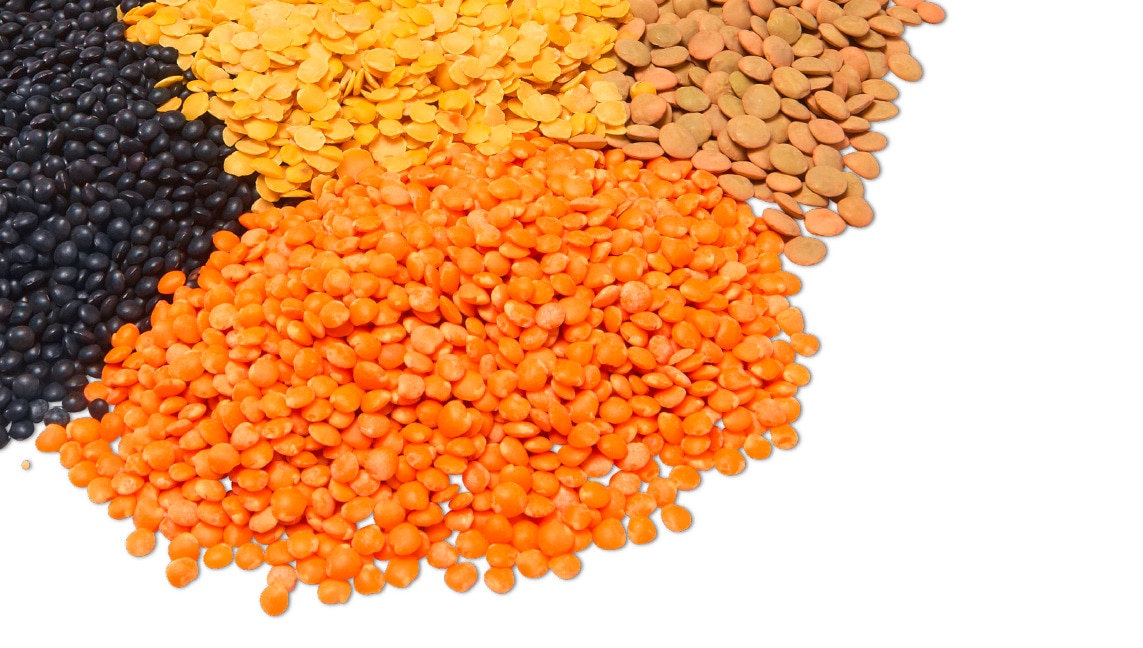Skip to:
If you’re interested in adding more plant-based meals to the menu, lentils are one of the first things you should turn to. These tiny nutrition powerhouses are versatile and relatively quick and easy to prepare. And because dried lentils can be stored for up to a year, they’re a great pantry staple.
Lentils are originally from North Africa and Asia and are one of the world’s first cultivated crops. A cousin of the pea, it requires little water to grow and has a carbon footprint 43 times lower than that of beef. Plus the low cost of lentils makes them an accessible form of high-quality protein for many people around the world.
Lentils add a delicious earthy flavour to all sorts of dishes. They're a perfect addition to traditional dishes like curry or soup, but also delicious blended into veggie burgers, sauces, casseroles, and as a standalone main. Lentils are also common in vegan and vegetarian cuisine because they’re high in fibre, carbohydrates and protein.
Learn more about the benefits of lentils and how to cook this tasty and nutritious pulse.
Red vs Green Lentils
There are many different types of lentils, all with slightly different earthy, peppery or sweet flavours.
Among the most popular, yellow and red lentils are mild and sweet with a slight nutty flavour, and are commonly used in Indian and Middle Eastern dishes. They cook in about 15-20 minutes and tend to dissolve into a rich purée and are delicious mixed into stews, curries, soups and veggie burgers.
Green lentils work particularly well over salads and as a warm side, because of their peppery taste. They do take the longest to cook of all the varieties (about 45 minutes), but hold their shape well.
How to Cook Lentils
Not only are lentils tasty and nutritious and a great way to add protein to salads, side dishes and more, but they are also simple to cook. Follow these three easy steps to perfectly cooked lentils:
- Pre-soak the lentils, if necessary.
- Add the lentils to boiling water or stock/broth (3:1 ratio of water to lentils)
- Boil for 15 to 20 minutes for whole lentils and 5 to 7 minutes for split lentils.
Did you know? You can refrigerate pre-cooked lentils to keep on hand as a quick protein source!
Health Benefits of Lentils
Lentils are loaded with protein and fibre which are great for strong muscles and a happy digestive system. They’re also rich in immune supporting zinc, and folate, which helps support healthy bones and teeth.
Just 1/2 cup of cooked lentils provides 15% of your daily iron needs!1 For vegetarians, getting enough iron is particularly challenging. Iron plays a crucial role in the formation of hemoglobin and myoglobin, both of which carry oxygen to the cells. That is why fatigue and tiredness are usually the first symptoms people notice when they are low in iron.
How many calories in lentils are there?
- There are 150 calories in one half cup (125ml) of cooked split red lentils, 12g protein, 4g fibre, 12mg calcium, and 3mg iron.2
- In one half cup (125ml) of cooked whole green lentils, there are 140 calories, 12g protein, 9g fibre, 25mg calcium, and 2mg iron.3
Lentils Recipes
Including lentils in your diet is easier than you think. You can add them to soups or stews for extra nutrients and fibre, use them to replace beans in any recipe, or even as a dip. Simply mash cooked lentils with a fork and add garlic, onion, chili powder, and chopped tomatoes.
Here are some more lentil recipes and inspiration:
- This Hearty Lentil Stew recipe is a quick and easy, nutritious and delicious meatless dish to pull together.
- Make these Vegan Lentil Balls as a healthy game day snack or add them to your lunch box as a nutritious workday meal.
- This Enchiladas recipe includes chili sin carne, tofu and lentils. It’s a high-protein family favourite!
- For a vegetarian dish that will make everyone smile, try out this Chipotle Instant Pot Chili recipe.
- A weeknight winner, you can pull this Brown Butter Squash and Lentils recipe together in just 20 minutes.
Besides being tasty and versatile, lentils are good for you and good for the planet. Which is why we included them on our list of Future 50 Foods, a list of 50 ingredients we believe we should be eating more of, because of their advantages to our health, but also how they benefit our planet.
1. https://www.lentils.org/health-nutrition/nutritional-information/
2. https://www.lentils.org/health-nutrition/nutritional-information/
3. https://www.lentils.org/health-nutrition/nutritional-information/

